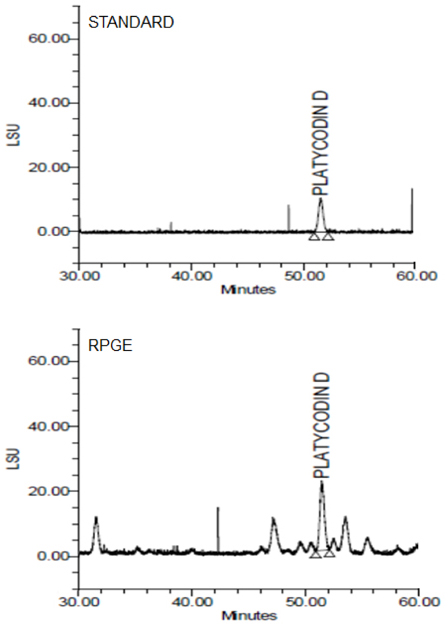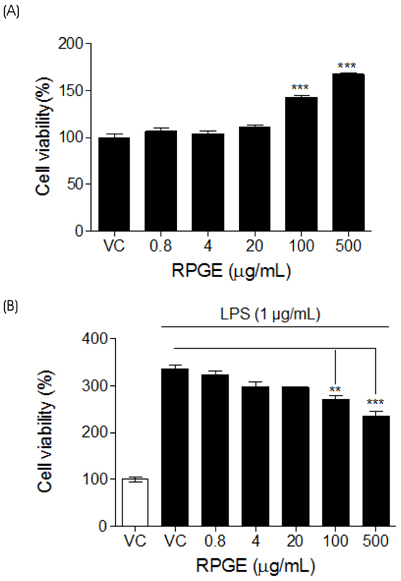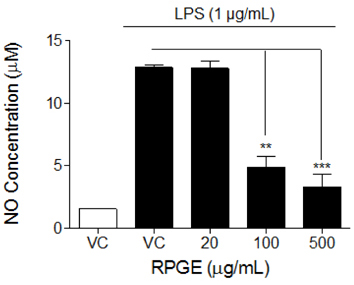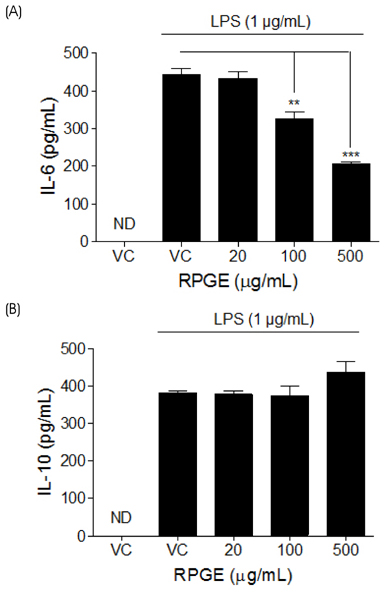J Nutr Health.
2019 Jun;52(3):243-249. 10.4163/jnh.2019.52.3.243.
Mitigation effects of red Platycodon grandiflorum extract on lipopolysaccharide-induced inflammation in splenocytes isolated from mice
- Affiliations
-
- 1Department of Food and Nutrition, Gachon University, Seongnam, Gyeonggi 13120, Korea. skysea@gachon.ac.kr
- 2Food R&D Center, SK Bioland Co., Ltd, Ansan, Gyeonggi 15407, Korea.
- 3National Institute of Agricultural Sciences, Rural Department Administration, Wanju, Jeonbuk 55365, Korea.
- KMID: 2450421
- DOI: http://doi.org/10.4163/jnh.2019.52.3.243
Abstract
- PURPOSE
Platycodon grandiflorum (PG) is known to have effective antimicrobial and anticancer activity. The main bioactive components of PG are saponins, and these could contribute to anti-inflammatory activity. However, little is known about the anti-inflammatory effect of PG. In this study, we aim to assess the anti-inflammatory response to Red PG Extract (RPGE) in splenocytes under ex vivo conditions.
METHODS
The cell viability of isolated splenocytes taken from mice was analyzed by performing a Cell Counting Kit-8 assay. The productions of nitric oxide (NO) and cytokines (specifically interleukin-6 (IL-6) and interleukin-10 (IL-10)) were measured utilizing Griess reagent and ELISA, respectively.
RESULTS
We found that co-treatment with RPGE and Lipopolysaccharide (LPS) decreased isolated splenocyte proliferation as compared with that of the LPS-stimulated control. We also observed that RPGE markedly suppressed NO synthesis and IL-6 production that was induced by LPS. There were no significant differences of IL-10 production between co-treatment with RPGE plus LPS and treatment with LPS alone.
CONCLUSION
When taken together, our data has shown that RPGE mitigates LPS-induced inflammation in splenocytes isolated from mice. Further research is surely needed to confirm the anti-inflammation effects of RPGE in an in vivo model.
MeSH Terms
Figure
Reference
-
1. Kovarik J. From immunosuppression to immunomodulation: current principles and future strategies. Pathobiology. 2013; 80(6):275–281.
Article2. Song MR, Kang MH, Park JS, Jo HK. A comparative study of the prevalence of allergic disease between rural and urban elementary school students. J Korean Acad Child Health Nurs. 2012; 18(1):29–35.
Article3. Chen L, Deng H, Cui H, Fang J, Zuo Z, Deng J, et al. Inflammatory responses and inflammation-associated diseases in organs. Oncotarget. 2017; 9(6):7204–7218.
Article4. Park SO, Han YW, Aleyas AG, George JA, Yoon HA, Eo SK. The kinetics of secondary response of antigen-specific CD4+ T cells primed in vitro with antigen. Immune Netw. 2006; 6(2):93–101.5. Azab A, Nassar A, Azab AN. Anti-inflammatory activity of natural products. Molecules. 2016; 21(10):E1321.
Article6. Han HS, Jang E, Shin JS, Inn KS, Lee JH, Park G, et al. Kyungheechunggan-tang-01, a new herbal medication, suppresses LPS-induced inflammatory responses through JAK/STAT signaling pathway in raw 264.7 macrophages. Evid Based Complement Alternat Med. 2017; 2017:7383104.
Article7. Mebius RE, Kraal G. Structure and function of the spleen. Nat Rev Immunol. 2005; 5(8):606–616.
Article8. Lee CW, Ko EJ, Joo HG. Immunostimulatory effects of BCG-CWS on the proliferation and viability of mouse spleen cells. Korean J Vet Res. 2012; 52(2):89–97.
Article9. Erridge C, Bennett-Guerrero E, Poxton IR. Structure and function of lipopolysaccharides. Microbes Infect. 2002; 4(8):837–851.
Article10. Wink DA, Mitchell JB. Chemical biology of nitric oxide: Insights into regulatory, cytotoxic, and cytoprotective mechanisms of nitric oxide. Free Radic Biol Med. 1998; 25(4-5):434–456.
Article11. Matsuda H, Morikawa T, Ando S, Toguchida I, Yoshikawa M. Structural requirements of flavonoids for nitric oxide production inhibitory activity and mechanism of action. Bioorg Med Chem. 2003; 11(9):1995–2000.
Article12. Calixto JB, Campos MM, Otuki MF, Santos AR. Anti-inflammatory compounds of plant origin. Part II. modulation of pro-inflammatory cytokines, chemokines and adhesion molecules. Planta Med. 2004; 70(2):93–103.
Article13. Bachus H, Kaur K, Papillion AM, Marquez-Lago TT, Yu Z, Ballesteros-Tato A, et al. Impaired tumor-necrosis-factor-α-driven dendritic cell activation limits lipopolysaccharide-induced protection from allergic inflammation in infants. Immunity. 2019; 50(1):225–240.
Article14. Hong MW. Statistical analyses of Platycodi radix prescriptions. Korean J Pharmacogn. 1975; 19:177–188.15. Lee SJ, Bang WS, Hong JY, Kwon OJ, Shin SR, Yoon KY. Antioxidant and antimicrobial activities of black Doraji (Platycodon grandiflorum). Korean J Food Preserv. 2013; 20(4):510–517.
Article16. Wang C, Schuller Levis GB, Lee EB, Levis WR, Lee DW, Kim BS, et al. Platycodin D and D3 isolated from the root of Platycodon grandiflorum modulate the production of nitric oxide and secretion of TNF-alpha in activated RAW 264.7 cells. Int Immunopharmacol. 2004; 4(8):1039–1049.17. Hwang IG, Woo KS, Jeong HS. Biological activity and heat treatment processing of foods. Food Sci Ind. 2011; 44(3):56–65.18. Kim SY, Lee YJ, Park DS, Kim HR, Cho YS. Comparison of quality characteristics of Platycodon grandiflorum according to steaming and fermentation. Korean J Food Preserv. 2015; 22(6):851–858.
Article19. Lee BJ, Jeon SH, Lee SW, Chun HS, Cho YS. Effect of drying methods on the saponin and mineral contents of Platycodon grandiflorum radix. Korean J Food Sci Technol. 2014; 46(5):636–640.
Article20. Lee IS, Choi MC, Moon HY. Effect of Platycodon grandiflorum A. DC extract on the bronchus diseases bacteria. Korean J Biotechnol Bioeng. 2000; 15(2):162–166.21. Nyakudya E, Jeong JH, Lee NK, Jeong YS. Platycosides from the roots of Platycodon grandiflorum and their health benefits. Prev Nutr Food Sci. 2014; 19(2):59–68.
Article22. Nam KY. The comparative understanding between red ginseng and white ginsengs, processed ginsengs (Panax ginseng C. A Meyer). J Ginseng Res. 2005; 29(1):1–18.23. Birbrair A, Frenette PS. Niche heterogeneity in the bone marrow. Ann N Y Acad Sci. 2016; 1370(1):82–96.
Article24. O'Garra A, Arai N. The molecular basis of T helper 1 and T helper 2 cell differentiation. Trends Cell Biol. 2000; 10(12):542–550.25. Lappin MB, Campbell JD. The Th1-Th2 classification of cellular immune responses: concepts, current thinking and applications in haematological malignancy. Blood Rev. 2000; 14(4):228–239.
Article26. Mulder R, Banete A, Basta S. Spleen-derived macrophages are readily polarized into classically activated (M1) or alternatively activated (M2) states. Immunobiology. 2014; 219(10):737–745.
Article27. Tugal D, Liao X, Jain MK. Transcriptional control of macrophage polarization. Arterioscler Thromb Vasc Biol. 2013; 33(6):1135–1144.
Article28. Hawrylowicz CM, O'Garra A. Potential role of interleukin-10-secreting regulatory T cells in allergy and asthma. Nat Rev Immunol. 2005; 5(4):271–283.
Article29. O'Garra A, Vieira PL, Vieira P, Goldfeld AE. IL-10-producing and naturally occurring CD4+ Tregs: limiting collateral damage. J Clin Invest. 2004; 114(10):1372–1378.30. Chauhan SK, Saban DR, Lee HK, Dana R. Levels of Foxp3 in regulatory T cells reflect their functional status in transplantation. J Immunol. 2009; 182(1):148–153.
Article31. Lin JY, Li CY, Hwang IF. Characterisation of the pigment components in red cabbage(Brassica oleracea L. var.) juice and their anti-inflammatory effects on LPS-stimulated murine splenocytes. Food Chem. 2008; 109(4):771–781.
- Full Text Links
- Actions
-
Cited
- CITED
-
- Close
- Share
- Similar articles
-
- Immune-enhancing effect of hydrolyzed and fermented Platycodon grandiflorum extract in cyclophosphamide-induced immunosuppressed BALB/c mice
- Immunomodulatory effects of fermented Platycodon grandiflorum extract through NF-κB signaling in RAW 264.7 cells
- Inhibitory effect of the aqueous extract of a tetraploid ‘etteum’ variety in Platycodon grandiflorum on degranulation and inflammatory mediator release in RBL-2H3 cells
- Growth Inhibitory Effects of Various Herbal Extracts on Metronidazole Resistant Strain of Trichomonas vaginalis
- Comparison of Vasodilator Effects of Platycodin D and D3 in Rats





